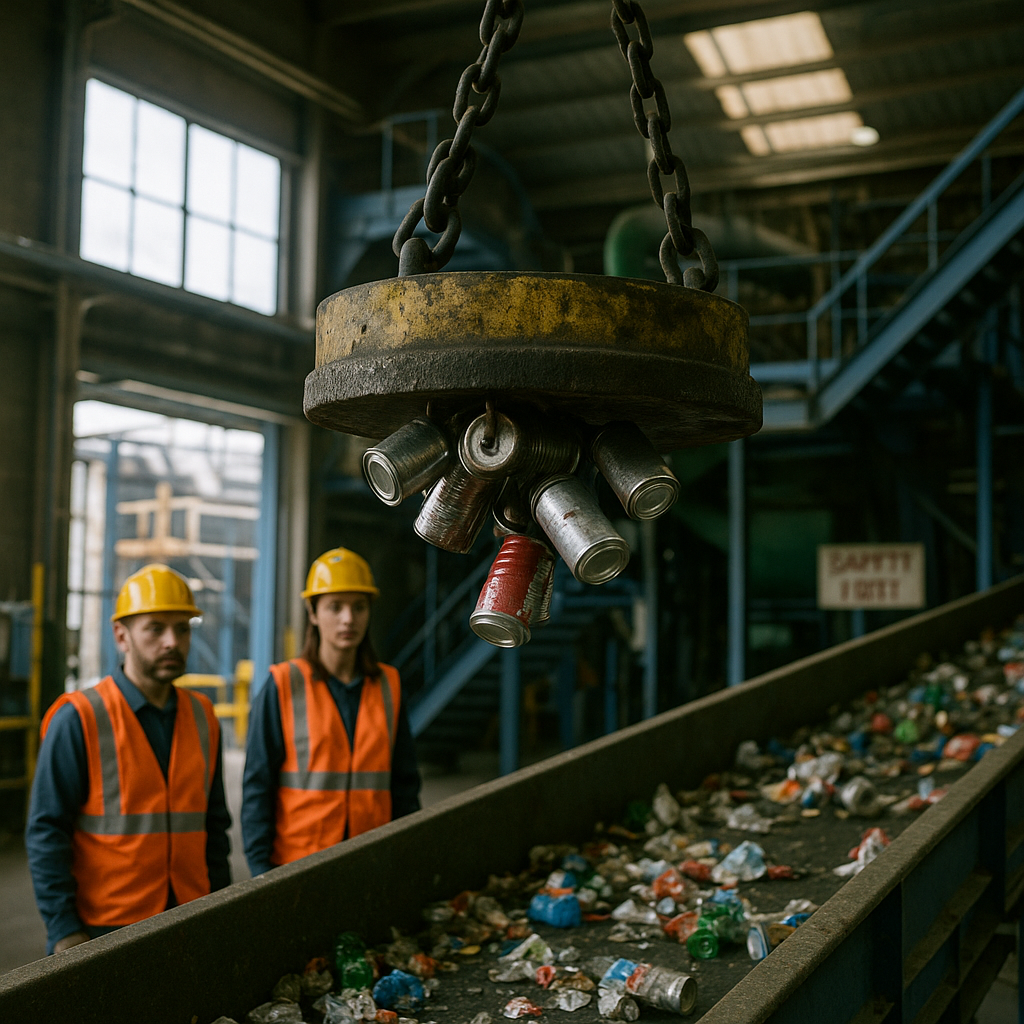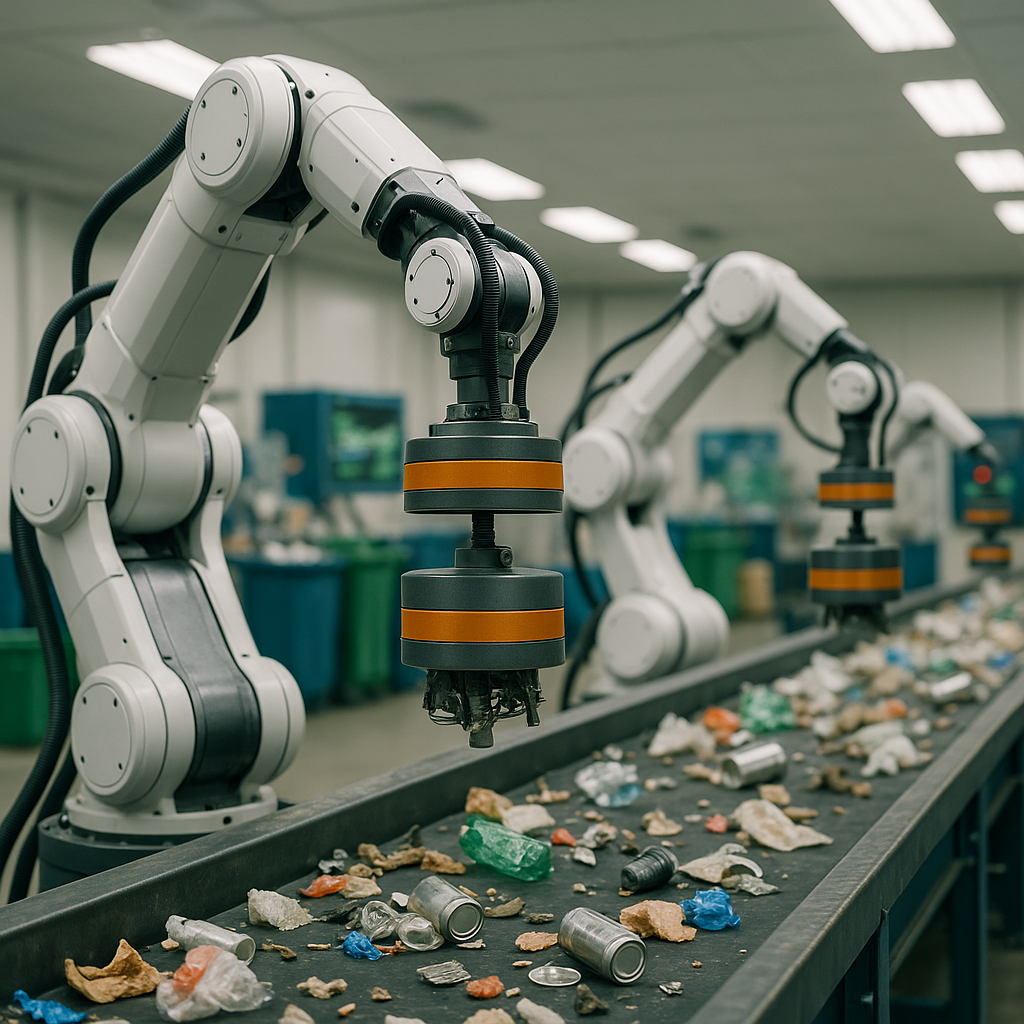5901 Botham Jean Blvd, Dallas, TX 75215
Magnets for Recycling: How Magnetic Separation Boosts Metal Recovery, Purity, and Efficiency
September 3, 2025Metal recycling has been a cornerstone of resource conservation for centuries. From ancient Romans repurposing bronze statues into weapons to Vikings reforging broken swords, humans have long recognized the value of reclaiming metals. Modern metal recycling began to take shape in the 1920s with the establishment of scrapyards, and by the 1940s, recycled metals were essential for manufacturing airplanes and automotive parts during wartime production.
Magnets for recycling are specialized tools that transformed the metal recycling industry when first introduced in the 1960s. These powerful devices offer a straightforward, efficient method for separating various types of metals in waste streams. Permanent magnets create persistent magnetic fields without electricity, making them ideal for continuous use in recycling facilities.
The principle behind magnetic separation is simple yet effective. Ferrous metals—those containing iron—are naturally attracted to magnets. This attraction allows recycling facilities to easily identify and extract materials like steel, cast iron, and tin from mixed waste. Non-ferrous metals such as aluminum, copper, and brass remain unaffected by the magnetic field, enabling clean separation of different metal types.
How Do Magnets Work in the Recycling Process?

Magnetic separation in recycling facilities relies on a straightforward scientific principle: ferrous metals contain iron, making them magnetic. When exposed to a magnetic field, these metals are attracted to the magnet, while non-ferrous materials continue on their path.
Recycling plants typically use permanent magnets rather than electromagnets for most separation processes. These magnets create constant magnetic fields without requiring electricity, making the separation process energy-efficient and environmentally friendly.
Types of Magnetic Separators
Several magnetic separators play crucial roles in modern recycling facilities, each serving specific purposes within the waste management stream.
Overhead magnets are suspended above conveyor belts carrying mixed waste. These powerful magnets pull ferrous metals upward and away from the material stream. The attracted metals stick to the magnet until reaching a discharge point, where they fall into a separate collection area.
Drum magnets consist of a rotating drum with internal stationary magnets. As materials pass over the drum, ferrous metals adhere to the outer shell. The rotation carries these metals to a discharge point, while non-magnetic materials fall away naturally.
Magnetic pulleys replace standard head pulleys on conveyor belts. They contain powerful permanent magnets inside a non-magnetic shell. As the belt moves over the pulley, ferrous metals remain attached slightly longer, creating a separate trajectory for magnetic materials and allowing them to fall into a different collection bin.
The Separation Process
The recycling process begins when mixed waste enters the facility on conveyor belts. Overhead magnets make the first pass, removing larger ferrous items. The remaining materials continue to other separation stages.
Magnetic drums often follow, capturing smaller ferrous particles missed by overhead systems. The rotation speed and magnetic strength determine separation efficiency, and plants calibrate these settings based on the waste composition.
For non-ferrous metals like aluminum, recyclers use eddy current separators. These devices generate magnetic fields that induce electric currents in non-ferrous metals, creating a repulsive force that pushes aluminum away from other materials.
The combination of these magnetic technologies ensures maximum metal recovery from waste streams, increasing the value of recycled materials and reducing landfill waste.
Efficiency and Effectiveness
Magnetic separation achieves remarkable efficiency in modern recycling. Quality systems can recover over 90% of ferrous metals from mixed waste streams, making magnetic separation a cornerstone of sustainable waste management.
The purity of separated materials directly impacts their recycling value. Magnetic separators produce clean ferrous streams with minimal contaminants, allowing metals to be melted and reformed with less processing.
The speed of magnetic separation also contributes to efficient recycling operations. Modern systems process tons of material hourly with minimal human intervention, reducing costs while improving recovery rates.
Magnetic separation represents an elegant solution to complex waste sorting challenges. By harnessing basic magnetic principles, recycling facilities efficiently recover valuable metals from waste streams, conserving natural resources and reducing environmental impact.
What Types of Magnets are Used in Recycling?

The recycling industry relies on several types of magnets to efficiently separate and sort materials. Each type offers distinct advantages for specific recycling applications. Understanding these differences helps facilities choose the best magnetic technology for their material recovery needs.
Permanent Magnets
Permanent magnets maintain their magnetic properties without requiring an external power source, making them energy-efficient and reliable for continuous recycling. Their persistent magnetism ensures consistent performance in material separation processes.
Among permanent magnets, ceramic (ferrite) magnets are the most widely used in recycling. Made from iron oxide combined with barium or strontium carbonate, these magnets offer excellent corrosion resistance and can operate effectively at temperatures up to 300°C. Despite their lower magnetic strength compared to other types, their affordability makes them ideal for large-scale operations.
Alnico magnets, composed of aluminum, nickel, and cobalt, excel in high-temperature environments. They function reliably at temperatures up to 540°C while maintaining impressive magnetic stability, making them suitable for specialized recycling applications where heat resistance is crucial.
Rare Earth Magnets
Rare earth magnets are the strongest type of permanent magnets available. In recycling facilities, they are used where exceptional magnetic strength is needed, such as extracting small ferrous particles from waste streams or separating closely similar materials.
Neodymium magnets (NdFeB) generate magnetic fields between 1.0-1.4 teslas, making them extremely powerful. These magnets are particularly valuable in applications with space constraints or where stronger magnetic fields are needed to capture smaller metal particles. However, they function optimally only up to 200°C and require protective coatings to prevent corrosion.
Samarium cobalt (SmCo) magnets offer exceptional corrosion resistance and can withstand temperatures up to 350°C without significant loss of magnetic properties. Their strong resistance to demagnetization makes them suitable for specialized recycling equipment in harsh environments or high-temperature conditions.
Electromagnetic Separators
Electromagnets differ from permanent magnets as they create magnetic fields using electricity. When electric current flows through a wire coiled around a metal core, it generates a controllable magnetic field, allowing operators to turn the magnetism on and off as needed.
Electromagnetic separators provide flexibility in material handling systems where magnetism needs to be switched on for sorting and off for material release. The strength of these magnets can be adjusted by controlling the electric current, enabling precise calibration for different materials. They are commonly used in applications where materials must be temporarily magnetized for sorting and then demagnetized for further processing.
Factors Influencing Magnet Selection
Several key factors determine the most appropriate magnet type for a specific recycling application. The type of material being processed is a primary consideration, as ferrous metals require different magnetic strengths than materials with minimal iron content.
The desired purity of the output significantly impacts magnet choice. Higher purity requirements may necessitate stronger magnets or multiple separation stages. Processing volume is equally important, as high-volume operations may benefit from electromagnets that can handle continuous material flows, while smaller operations might find permanent magnets more cost-effective.
Environmental conditions also play a crucial role. Facilities with high-temperature processing areas require magnets with appropriate heat resistance. Budget constraints inevitably influence decisions, with ceramic magnets offering cost-effectiveness for basic applications, and rare earth magnets providing superior performance at higher price points.
In modern recycling facilities, these different magnet types often work together in integrated systems. For example, a facility might use powerful electromagnets for the initial separation of large ferrous items, followed by rare earth magnets to capture smaller metal particles from the remaining waste stream. This layered approach maximizes recovery efficiency while optimizing operational costs.
What are the Benefits of Using Magnets in Recycling?

Magnetic separation technology has transformed recycling operations. By utilizing magnets to attract ferrous materials, recycling facilities have enhanced their processing capabilities and environmental outcomes. Implementing magnetic systems in recycling plants offers concrete advantages that go beyond basic metal recovery.
Increased Processing Efficiency
Magnets significantly improve recycling efficiency by automating the sorting process. Rather than relying on manual sorting, which is time-consuming and labor-intensive, magnetic separators can quickly process large volumes of mixed materials. Automation reduces the need for human intervention and speeds up the recycling workflow.
The speed of magnetic separation systems is particularly notable. Modern drum magnets and overband magnetic separators can process several tons of material per hour, allowing recycling facilities to handle much larger waste streams than would be possible manually. This throughput is vital for managing the growing quantities of waste generated today.
For smaller recycling operations, implementing magnetic separation can reduce labor costs by up to 30%, allowing resources to be redirected to other critical parts of the recycling process.
Enhanced Material Purity
A significant benefit of magnetic separation in recycling is the improvement in material purity. By efficiently removing ferrous metals from other recyclable materials, magnetic systems ensure fewer contaminants in each stream, increasing the value of recycled materials.
When plastics, paper, glass, or non-ferrous metals are contaminated with iron or steel particles, their recycling potential and market value diminish notably. Magnetic separation prevents this cross-contamination, ensuring each material stream meets quality standards for reprocessing, resulting in recycled materials that command premium prices.
Recycling facilities using advanced magnetic separation technology typically achieve ferrous metal removal rates exceeding 95%, significantly improving the purity of downstream material streams.
Equipment Protection and Maintenance Savings
Metal contaminants pose a serious threat to processing equipment. Sharp metal pieces can damage conveyor belts, shredders, grinders, and other machinery used in recycling. Magnetic separators installed at strategic points in the processing line protect valuable equipment by removing potentially damaging metal objects before they cause harm.
This preventive function translates to substantial maintenance savings. Recycling facilities with magnetic separation systems report fewer equipment breakdowns, reduced replacement part costs, and less downtime for repairs. The investment in magnetic technology often pays for itself through extended equipment lifespan and lower maintenance expenses.
A single major equipment failure due to metal contamination can cost recycling facilities thousands of dollars in repairs and lost production time. Magnetic separators provide essential protection against these costly incidents.
Environmental Conservation Benefits
The environmental advantages of magnetic recycling extend beyond material recovery. By improving metal recovery rates, magnetic separation ensures more ferrous materials are diverted from landfills and returned to productive use, conserving resources and representing a fundamental environmental benefit.
Additionally, recycling metals requires significantly less energy than producing new metals from raw ore. For example, steel recycling uses approximately 75% less energy than making new steel from iron ore. By facilitating more efficient metal recovery, magnetic separation directly contributes to energy conservation and reduced carbon emissions.
The environmental impact is substantial. For every ton of steel recycled using magnetic separation systems, approximately 1.5 tons of iron ore, 0.65 tons of coal, and 0.3 tons of limestone are conserved, along with the energy needed to process these raw materials.
Economic Advantages
The economic benefits of magnetic separation in recycling are compelling. By recovering valuable metals that would otherwise be lost, recycling facilities generate additional revenue streams. Automating the sorting process reduces labor costs while increasing throughput, improving overall operational efficiency.
Further, the production of higher-purity recycled materials leads to better market prices. Clean, well-sorted materials free from contaminants command premium rates from manufacturers seeking quality recycled inputs. This quality premium enhances the economic viability of recycling operations.
Some recycling facilities report up to 20% higher revenues for properly sorted ferrous metals compared to mixed metal streams, directly attributed to the implementation of effective magnetic separation systems.
Technical Innovation and Versatility
Modern magnetic separation systems offer impressive versatility across different recycling applications. From municipal solid waste processing to electronic waste recycling, magnetic technologies can handle various material streams and operating conditions.
The recycling industry benefits from multiple types of magnetic separators, including drum magnets, overband magnets, pulley magnets, and eddy current separators for non-ferrous metals. This diversity allows recycling facilities to customize magnetic separation systems based on specific operational needs and material characteristics.
Each technological advancement in magnetic separation enhances recovery rates and processing capabilities, continually improving the performance of recycling operations and their environmental outcomes.
Conclusion: The Future of Magnets in Recycling

With increasing global emphasis on sustainability, the role of magnets in recycling is set to grow substantially. The metal recycling market is expected to surpass $368 billion by 2030, fueled by economic incentives and environmental needs. This trend underscores the importance of recycling in addressing resource scarcity and reducing environmental impact.
Technological advancements in magnetic separation are transforming recycling operations. Innovations in rare earth magnets result in more powerful and efficient separation systems, allowing for the recovery of smaller metal particles with greater precision. These enhancements maximize resource recovery from complex waste streams. Meanwhile, sensor-based sorting technologies work alongside magnetic systems to develop comprehensive recycling solutions that support the shift to a circular economy.
For assistance with your recycling operations and to take advantage of these advanced magnetic technologies, contact Okon Recycling at 214-717-4083.
